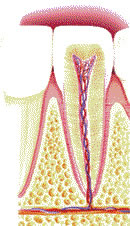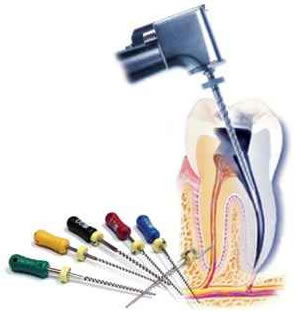Our endodontist is a dentist who is trained to diagnose and treat problems located inside of the tooth with special endodontic equipment. As specialists they focus solely on endodontic procedures. Endodontics, or Root Canal, is the prevention, diagnosis and treatment of disorders of the dental pulp. The pulp is made up of nerves, blood vessels, and connective tissue, which are important in tooth development.


The procedure
The Root Canal procedure usually requires one to two visits, depending on the number of teeth and severity affected. However, this does not include follow up visits which are often necessary.
Step 1
The endodontist will examine the tooth and x-rays before numbing the area around the affected tooth. A small protective sheet called a “dental dam,” is placed over the area. This will isolate the tooth and keep it clean and free of saliva throughout the procedure.
Step 2
They will then drill through to the pulp area, either through the top or the back of the tooth. Very small instruments and an antiseptic solution will be used to clean the pulp and root canals and a space is shaped for a filling.
Step 3
When the space has been cleaned and shaped, the endodontist will fill the root canal with a biocompatible material. This is usually a flexible plastic material called “gutta-percha” ensuring that the root canals are completely sealed. Normally, a temporary filling will be inserted to close the opening. The temporary filling will be removed by your dentist before the tooth is restored.
Step 4
After your final visit to your endodontist, you must return to your dentist for the restoration work. If there is no sign of any infection a crown or permanent filling will be inserted within a month of the root canal procedure.
Step 5
If the tooth is too weak to hold the restoration in place, your dentist or endodontist may place a post inside the tooth. Ask your endodontist for more details about the specific restoration planned for your tooth.
Advantages & Disadvantages of Endodontics
Advantages
- Pain is always associated with root canals, but the truth is that there should be little or no pain during the procedure.
- We do not carry out this procedure for aesthetic reasons, for the good of your health.
- Any infection will only get worse with time, if left untreated.
- The root canal procedure has a success rate of over 92 percent.
- The greatest advantage is that the tooth will not need to be extracted in the future.
Disadvantages
- Occasionally, infected tissue is pushed through the ends of the root infecting the gum. This can be treated easily, but there will be some pain until the infection is cleared up.
- Canals are irregularly shaped, and if the canal is not accurately measured then it won’t be cleaned or filled properly. This will cause the pulp to become infected again and a second procedure will be necessary.



